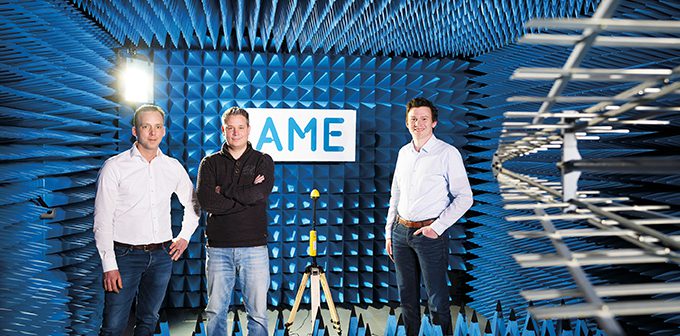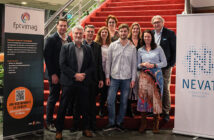The IoT( internet-of-things ) must add more value
The Internet of things (IoT) is a crucial ingredient of the smart industry, but it is also booming in consumer electronics. Any half-decent device is connected to the cloud and can be operated using a smartphone or tablet. The Eindhoven-based AME develops IoT solutions for industrial and consumer applications: electronics with integrated connectivity, a cloud service for access, apps and dashboards for control. Using self-learning algorithms, the data is rendered fit for use by the customer. In addition, big data is collected, enabling customers to add increasingly more value to their product. ‘AME offers its clients the total solution including the IoT.’
AME (Applied Micro Electronics) is an independent developer and producer of high-quality electronic modules and products. The Eindhoven-based firm has 240 staff, most of whom work in product and process development. The focus is on three core technologies: power conversion, the internet of things and sensors and actuators, with the corresponding highly automated production facilities. AME has been developing IoT solutions for over a decade, ever since the day it was still called telemetry (sending data over telephone lines) or machine-to-machine communication. Electronics with RF technology (radiofrequency) handle the communication, mostly wireless using Wi-Fi or Bluetooth. This is used to collect data from, for example, sensors for the purpose of production control and monitoring in plants, but also for climate control at home. The big data is analysed and clarified on servers (cloud) that are stationed at AME but which may also be installed and maintained on a client’s site. AME is concerned with the success of the product and therefore the firm also supplies the associated apps and web applications for a wide range of IoT applications.
Final responsibility
‘AME offers customers a total solution including the IoT’, says director Roel van Wijlen. ‘Our business model is based on the development and supply of products. The success of a product depends on the integration of all elements surrounding the IoT solution. That’s why we want to take total responsibility, including for hardware, software and aspects such as the cloud and app. The customer is happy with one point of contact.’ This gives the least cause for discussion, explains Erick van den Ackerveken, software architect at AME-R&D. ‘If other parties, or the customer themselves, shoulder part of the responsibility, you need someone to manage the interface between the various ‘worlds’. Moreover, customers often ask for a speedy delivery, for a trade fair presentation or product introduction, for example. We have ready-to-use partial solutions available, enabling us to accurately assess and control the risks.’ But even if the customer retains final responsibility, AME will conduct the integration test with all components. Bram van Nunen, AME-R&D manager, says, ‘There are few companies like us that do both development and reproduction in-house. That’s why AME finds it so important that a solution works well as a whole. In addition, we ensure that a customer is not stuck with a certain IoT cloud platform; they can use the AME cloud or one offered by third parties.’
At home and in the factory
The list of IoT applications has become endless. Van Nunen mentions the waste compactor, which AME long ago fitted with a telemetry system that produced a warning if the container needed emptying; this saved the waste processor many unnecessary rides. Or the industrial oven fitted with temperature sensors for the best baking result. However, a current trend is that many consumer products in particular are fitted with an IoT solution, from e-bikes to coffee machines. ‘These devices used to be operated using buttons and a display; the app is now used for this, which requires IoT connectivity. Van Wijlen adds that Wi-Fi and Bluetooth are now becoming affordable. ‘Fifteen years ago, subscriptions for, say, mobile telephones were expensive. So people only bought them if they provided sufficient added value. Integrating this technology now only costs a few euros. As Wi-Fi and Bluetooth are available on every smartphone, these have become the standard. As a consequence, the number of applications for the consumer market is increasingly rapidly. A concurrent trend is the increase in the industrial use of the IoT, under the denominator of ‘Factory 4.0′. This does not by definition only involve wireless solutions, but especially the collection and analysis of data by means of self-learning algorithms and rules.’
‘AME offers its clients the total solution including the IoT.’
Domotics is a popular IoT consumer application: home automation for lighting, heating, curtains, et cetera. Van den Ackerveken gives a practical example: ‘Closing the curtains and switching on the lights at the same time. ‘Major companies now offer their own Smart Home platforms, such as Google Home, Apple’s HomeKit and Amazon’s Alexa. These are open platforms, but you need to be MFi-certified (‘Made For iPod/iPhone/iPad’, Ed.) to manufacture a device that is able to communicate with HomeKit. AME is one of the few MFi-certified companies in the Netherlands.’
How and what
AME already has over 100,000 connected devices and Van Wijlen expects that number to grow exponentially in the coming years. Besides the further standardisation of the various hardware and software components – designed to allow quick configuration of application-specific IoT solutions – there are plenty of other challenges left, such as the following questions: What can you do with all that data? What conclusions do you draw? And which actions do you subsequently run? The algorithms used for this purpose are already self-learning: they adjust themselves based on the data processed. However, the ideal picture of big data – analysing it using artificial intelligence and running actions on the basis thereof – is still rarely seen in practice, says Van Wijlen. ‘That is first and foremost a limitation from the market, which is only just beginning with it. There is also still a lot of work to be done on data analysis itself. The added value of IoT can be raised significantly. The detection of anomalies, for example, can help predict whether a device is about to break down; indications include energy consumption or temperature that is significantly higher than the average in the installed base. AME has dedicated data scientists for this, but an important role is cut out for the customer, who brings in their domain knowledge and ultimately wants to be able to program those smart algorithms themselves.
As the recently deceased founder of AME Marc van Sloun said in Link last year: ‘AME puts the customer with their product in the foreground and uses its technology and advanced factories in the background to lay the basis for their success.’







